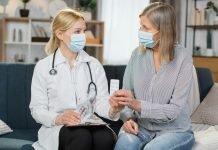
In a new study from University at Buffalo, researchers who do the genomic sequencing of the SARS-CoV2 virus in Erie County are seeing omicron cases increase, an indication that the region is exhibiting a similar trajectory to national trends.
And despite reports of a quick omicron spike in other countries, the scientists note that there are reasons why that may not be the case here.
Based on a batch of 344 samples taken through Dec. 21, the researchers report that the level of omicron in the region at that time was approximately 18%.
As of Dec. 25, omicron represented an estimated 58.5%of variants in the U.S., according to the Centers for Disease Control and Prevention, and it continues to climb.
Scientists noted that with such high numbers of omicron in Western New York, it is entirely likely that the sheer numbers will likely lead to higher hospitalizations, even though many people don’t experience severe illness.
They pointed out a key difference between the U.S. and South Africa, which has reported a quick peak and lower virulence.
The population in South Africa is just younger than in the U.S. and younger people are less likely to get seriously ill from SARS-CoV-2 infection, although some definitely do.
For these reasons, public health officials are once again urging people to do everything they can to limit the spread.
Researchers are asking people to continue to make choices that protect their health and those around them.
Get vaccinated and boosted, wear masks with a tight seal to the face, practice social distancing, and stay home and away from others when sick.
And if there are people in your lives who are more vulnerable to COVID-19 because of their age, immunocompromising conditions or vaccination status, make those good choices to protect them, too.
The team stressed the importance of what’s known as the “Swiss Cheese” model of preventing infection, which combines all these approaches: Get vaccinated. Wear good masks—cloth masks alone are no longer good enough.
Avoid large gatherings, especially indoors when masks cannot be used at all times. Get tested regularly. And recognize that rapid antigen testing is not perfect and can lead to false negatives.
A combined approach to preventing infection is best and will lower your risk significantly.
Concerns are growing about what looms ahead in the next few weeks based on the increased transmissibility of omicron and evidence that the incidence of the variant is continuing to rise.
Symptoms of the omicron variant include sore throat, nasal congestion, fatigue, headache, fever and loss of the ability to taste or smell.
In short, they can mimic those of any respiratory virus, but the team cautioned: “Do not equate omicron with the common cold.
Although early data suggests omicron may be less virulent than earlier variants, this is still a potentially lethal virus. And even so-called ‘mild’ infections can be pretty miserable.”
They added that those at highest risk for developing severe disease or a bad outcome from omicron include the unvaccinated, the immunocompromised, pregnant women, seniors and those with significant underlying disease, especially if not boosted.
If you care about Covid, please read studies that 40% of COVID-19 survivors have a new disability, and this old drug can save your life from COVID-19.
For more information about health, please see recent studies about COVID-19 vaccines that are only 66% effective against Delta variant, and results showing this drug can offer much-needed COVID-19 protection.
One researcher of the study is Allison Brashear, MD.
Copyright © 2022 Knowridge Science Report. All rights reserved.




